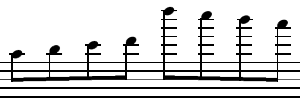
Is the Flute Easy or Hard to Play?
Is the Flute Easy or Hard to Play?
Ask any musician, flutist or otherwise, and they’re likely to tell you that their own particular instrument is the hardest to play! It's a common response because we all want to feel that we've mastered the most difficult instrument of all. However, there are many aspects of learning the flute that are really not hard at all. Even though each instrument isn't "hard" to play, each one has unique things to learn about. For example, flute players don't like playing the saxophone because it makes their lips buzz! And saxophone players sometimes don't like playing the flute because they feel they keep running out of air! Below, you’ll find some of the most common steps that flutists can take on their instruments to make the learning process simpler.
Step 1 - Learning the Lingo
Some people say that music is a language like any other, and often times beginning flute students can relate to this. Learning how to read music for the first time will feel like a very exciting step. Most adult students agree that it is a hugely satisfying feeling to be able to fluidly read music. Learning what all the curly symbols and strange blobs on the music mean and how they relate to you and your flute playing can at first feel a bit daunting. Investing some time in learning the basics of music theory will do wonders for improving your ability to read and understand music.![]() A side benefit of learning to read music is that you naturally learn a few dozen words in foreign languages - the most common one will be Italian, and sometimes French and German are used as well. Google (or a small music dictionary) is a wonderful tool in case you ever come across a new musical term in Italian, for example, that you haven't come across before.
A side benefit of learning to read music is that you naturally learn a few dozen words in foreign languages - the most common one will be Italian, and sometimes French and German are used as well. Google (or a small music dictionary) is a wonderful tool in case you ever come across a new musical term in Italian, for example, that you haven't come across before.
Step 2 - Standing Out in a Crowd
If you’re learning to play the flute for pure enjoyment, then this is a difficulty that may not be of much interest to you. But if you have any plans of playing the flute in the orchestra or band world, you’ll need to get used to the fact that there are lots (and I mean lots) of flute players out there, which means that it will be that much harder to stand out from the crowd and make a name for yourself. In most major orchestras, if a flute position becomes available, upwards of 50 flutists will audition for the spot! The GOOD thing about this however is that you know that if all these people could learn the flute successfully, then you can too.
Step 3 - Learning to Breathe

Breathing is something we do from the moment we are born without ever needing to be taught. However, learning to breathe properly on the flute is a different story. Poor breathing habits can lead to flute playing problems that range from not being able to sustain a note more than a few seconds to feeling quite lightheaded and dizzy. These breathing difficulties are only ever a problem if the student hasn't been taught by a skilled flute teacher. They can also be remedied with proper technique taught by an insightful flute teacher. A good starting point is to never take shallow breaths when playing the flute. Instead, work on some deep breathing techniques that will show you how to fill your lungs from the bottom up. It’s just a matter of learning to utilize your full lung capacity as well as being shown how to control the air with your muscles and your lips, which is actually far easier than it might sound. Learning to breathe properly is actually quite fun because you can discover how big your lungs really are and just how much air you can fit in there! Flute students can be very surprised what they're capable of when shown the right way
Step 4 - Ledger Lines as Far as the Eye Can See
If you’ve spent any time looking at sheet music, then you’re probably a little familiar with what "ledger lines" look like - the little floating lines above or below the regular 5 lines (called the staff). One of the problems that comes with playing an instrument with such an amazingly wide and high range like the flute is that the notes you’re capable of playing cannot be contained in the 5 lines alone, so composers must turn to ledger lines.
When you become more advanced at the flute, you'll begin reading these notes on the flute. It can be strange at first because the notes can all start to look the same! Over time flutists all become quite adept at interpreting ledger lines because they’re exposed to them so often, and they begin to feel as easy as reading any other lower note.
Photo credit: Four girls photo by Quatuor Eolia.




